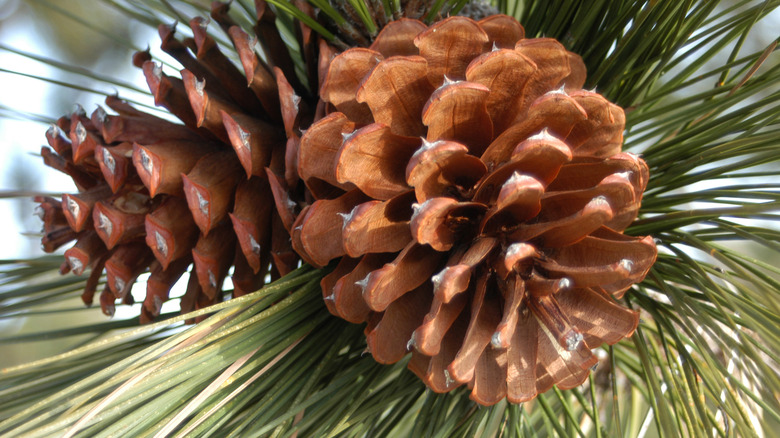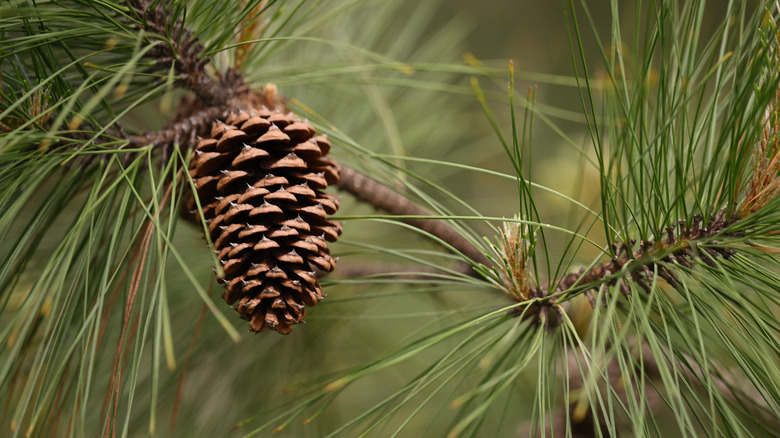Can You Really Grow A Flourishing Tree From A Pinecone? What We Know
Pinecones are beautiful little gifts that we receive each fall from pine trees. However, have you ever considered what their purpose is and where pine tree seeds come from? You can indeed grow a flourishing pine tree from a pinecone, but it's complicated. In the wild, special conditions allow for pine seed germination and growth. So, if you're going to try to grow pine trees from seed, you will have to recreate some of those conditions.
You can't just plant a pinecone and expect to grow a pine seedling. The pinecone is the woody container for the seed, so if you try planting it, the seed won't be able to escape the cone or get the sunlight it needs to germinate. Instead, you will have to harvest the seeds from the cone, stratify them, and then plant them. The process is pretty involved, unlike planting vegetable garden seeds from a packet. However, while it's not the easiest garden project, it's by no means impossible. With a little extra effort, it most certainly can be done, and it's a fun experiment to learn about the nuances of seed germination.
What is a pine cone?
A staple in fall and holiday decorations, and a warm signifier of the changing seasons, most of us are not strangers to the average pinecone. However, what really is a pinecone, and how does it grow into a tree? Well, in order to try to grow a pine tree, it would help if we understood what a pinecone is, how it functions, and its role in the development of pine tree seeds.
Pine trees belong to a family of prehistoric, ancient trees and plants called gymnosperms. The cone acts as the external shell and protection of the seed. There are male and female cones on virtually every pine tree; however, the ones we are familiar with are female. Following pollination, it can take up to 10 years for a pinecone to fully develop on a pine tree. When the cone matures, it opens up, and the seeds are dispersed through the wind or onto the ground. For germination to occur, most pine species need an environmental signifier, like the cold temperatures of winter (stratification), though some pines need fire to germinate.
Since pinecones belong to one of the oldest species of trees in the world, they've developed a specific reproductive habit that is not always easy for us humans to mimic. Furthermore, it takes some effort to recreate the perfect environment to germinate pine seeds.
How to grow a pine tree from a pinecone
If the pinecones have fallen to the ground, the seeds have most likely already dispersed. So, you're better off harvesting closed pinecones still on the tree. However, always use discretion and be mindful to collect from mature trees and ensure the variety you are harvesting is not endangered.
After selecting your pinecones, put them in a paper bag. You can warm them in a well-ventilated room to encourage them to open up. Shake the bag every few days to encourage the seeds to come out of the cones. Once the seeds have separated from the cone, put them in a resealable plastic bag and place them in the freezer for three months. This is known as cold stratification, which mimics the conditions of a cold winter.
After three months, plant your seeds in small, well-draining 4-inch pots. The potting mix should include peat moss, fine pine bark, and sand. Place the seed on top of the soil and cover it with just 0.25 inches of potting soil. The seed needs a bit of sunlight to germinate. Next, place the pots in a sunny window, monitor the soil's moisture, and never let it dry out or get too soggy. Once they've gotten a few inches tall, you can transplant them into the ground and watch them become pine trees.

